Entry Database : PDB / ID : 6b1nTitle Disrupted hydrogen bond network impairs ATPase activity in an Hsc70 cysteine mutant Heat shock protein family A (Hsp70) member 8 Keywords / / Function / homology Function Domain/homology Component
/ / / / / / / / / / / / / / / / / / / / / / / / / / / / / / / / / / / / / / / / / / / / / / / / / / / / / / / / / / / / / / / / / / / / / / / / / / / / / / / / / / / / / / / / / / / / / / / / / / / / / / / / / / / / / / / / / / / / Biological species Homo Sapiens (human)Method / / / Resolution : 1.8 Å Authors O'Donnell, J.P. Funding support Organization Grant number Country National Institutes of Health/National Institute of General Medical Sciences (NIH/NIGMS) GM105958
Journal : Biochemistry / Year : 2018Title : Disrupted Hydrogen-Bond Network and Impaired ATPase Activity in an Hsc70 Cysteine Mutant.Authors : O'Donnell, J.P. / Marsh, H.M. / Sondermann, H. / Sevier, C.S. History Deposition Sep 18, 2017 Deposition site / Processing site Revision 1.0 Jan 17, 2018 Provider / Type Revision 1.1 Feb 28, 2018 Group / Category / citation_authorItem _citation.journal_volume / _citation.page_first ... _citation.journal_volume / _citation.page_first / _citation.page_last / _citation.title / _citation_author.name Revision 1.2 Jan 1, 2020 Group / Category / Item Revision 1.3 Oct 4, 2023 Group Data collection / Database references ... Data collection / Database references / Derived calculations / Refinement description Category chem_comp_atom / chem_comp_bond ... chem_comp_atom / chem_comp_bond / database_2 / pdbx_initial_refinement_model / pdbx_struct_conn_angle / struct_conn Item _database_2.pdbx_DOI / _database_2.pdbx_database_accession ... _database_2.pdbx_DOI / _database_2.pdbx_database_accession / _pdbx_struct_conn_angle.ptnr1_auth_seq_id / _pdbx_struct_conn_angle.ptnr3_auth_seq_id / _pdbx_struct_conn_angle.value / _struct_conn.pdbx_dist_value / _struct_conn.ptnr2_auth_seq_id
Show all Show less
 Yorodumi
Yorodumi Open data
Open data Basic information
Basic information Components
Components Keywords
Keywords Function and homology information
Function and homology information Homo Sapiens (human)
Homo Sapiens (human) X-RAY DIFFRACTION /
X-RAY DIFFRACTION /  SYNCHROTRON /
SYNCHROTRON /  MOLECULAR REPLACEMENT / Resolution: 1.8 Å
MOLECULAR REPLACEMENT / Resolution: 1.8 Å  Authors
Authors United States, 1items
United States, 1items  Citation
Citation Journal: Biochemistry / Year: 2018
Journal: Biochemistry / Year: 2018 Structure visualization
Structure visualization Molmil
Molmil Jmol/JSmol
Jmol/JSmol Downloads & links
Downloads & links Download
Download 6b1n.cif.gz
6b1n.cif.gz PDBx/mmCIF format
PDBx/mmCIF format pdb6b1n.ent.gz
pdb6b1n.ent.gz PDB format
PDB format 6b1n.json.gz
6b1n.json.gz PDBx/mmJSON format
PDBx/mmJSON format Other downloads
Other downloads 6b1n_validation.pdf.gz
6b1n_validation.pdf.gz wwPDB validaton report
wwPDB validaton report 6b1n_full_validation.pdf.gz
6b1n_full_validation.pdf.gz 6b1n_validation.xml.gz
6b1n_validation.xml.gz 6b1n_validation.cif.gz
6b1n_validation.cif.gz https://data.pdbj.org/pub/pdb/validation_reports/b1/6b1n
https://data.pdbj.org/pub/pdb/validation_reports/b1/6b1n ftp://data.pdbj.org/pub/pdb/validation_reports/b1/6b1n
ftp://data.pdbj.org/pub/pdb/validation_reports/b1/6b1n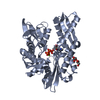
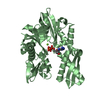
 Links
Links Assembly
Assembly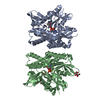
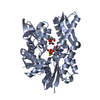
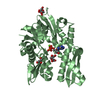
 Components
Components Homo Sapiens (human) / Production host:
Homo Sapiens (human) / Production host: 
 X-RAY DIFFRACTION / Number of used crystals: 1
X-RAY DIFFRACTION / Number of used crystals: 1  Sample preparation
Sample preparation SYNCHROTRON / Site:
SYNCHROTRON / Site:  CHESS
CHESS  / Beamline: A1 / Wavelength: 0.977 Å
/ Beamline: A1 / Wavelength: 0.977 Å Processing
Processing MOLECULAR REPLACEMENT
MOLECULAR REPLACEMENT Movie
Movie Controller
Controller


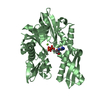
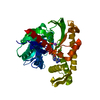
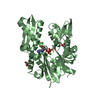
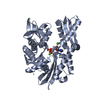
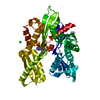
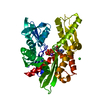


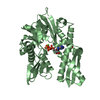

 PDBj
PDBj























